Ellondoth
The mysterious home of the Ellandari; a land as old as the world itself; the only realm to survive the Divine Calamity
Do not ask questions about Ellondoth. For neither do I. Neither does any scholar in any university, for that matter. To seek to learn anything about the high elves is a fool's errand. No force can penetrate their realm and no knowledge escapes it. Do not waste your studies or your careers on the subject. I would say that this is my final word on the matter but I know from experience that this won't be the last time one of you asks me about it...Ellondoth is the ancient and impenetrable nation of the high elves. Also known as the Realm Eternal, to the outside observer it has existed unchanged for thousands of years. Very little is actually known about Ellondoth to other civilizations of the Heartlands. The borders of the nation have remained closed throughout recorded history. Foreigners are never allowed to enter Ellondoth except on the rarest of diplomatic endeavors, and neither do Ellondothans venture outside the borders of their homeland.
Location and climate
Ellondoth is located in the central region of the Heartlands. It is bordered in the south by Egea and Tyria, in the west and north by Aredhen and in the east by the wild and unclaimed territory of Menargion. Ellondoth is almost entirely landlocked, having only a few dozen kilometers of coastline with the Golden Sea. From the outside, Ellondoth appears as an impenetrable woodland realm. Every section of its borders is guarded by evergreen sentinels of spruce, pine, and redwood; their ranks forming a carpet of forest that stretches as far as the eye can see. This circular zone of woodlands around the nation, uninhabited by elves, is known as Cormarierin, the Woods of the Ring-shape. Beoynd the woods lies another natural barrier encircling the central regions of Ellondoth: Dhongail Falas, the Humanshield Bogs. So treacherous are the wetlands that traversing them is nigh-impossible without magical assistance.Below: In ancient times the bogs of Dhongail Falas proved an insurmountable obstacle for foreign armies.
Due to the powerful enchantments placed in runestones at the borders of Ellondoth, no foreigner invader has tread upon Ellondothan soil for thousands of years. The extremely sophisticated spells placed in the border regions shield the realm from not only invasion but also magical probing.
Within Ellondoth proper there are various different biomes besides evergreen forest -- mainly swamps, river valleys and mixed forests pierced by a few shallow mountain ranges. The nation has a temperate climate, but natural conditions are heavily manipulated with magic by the high elves. Nature is nurtured and conserved to an extreme extent, and indeed both the flora and fauna of Ellondoth absolutely thrive.
Societal structure
Ellondoth functions as a highly refined liberal democracy that distributes power to every citizen, depending entirely on magical solutions to allow nation-wide communication and decision making. There are no social classes -- at least in theory -- with every citizen enjoying the same liberties and bearing the same responsibilities. Ellondoth has no ruler. International diplomacy is headed by High Queen Amariel who despite her title holds no power in national politics. Even decisions on foreign policy are largely dictated by parties other than the High Queen herself.Arcane lottocracy
National governance in Ellondoth is lottocratic, meaning that every law, decree, and ruling is made by a randomly designated jury of peers -- citizens chosen by lottery, obligated to serve their nation by participating in the decision making process. Lottocracy has done away the need for a centralized government. The lottery system is not entirely random, and certain mathematical designs guarantee that every citizen has to serve as a juror on more than one occasion during their life. From proposals to discussions to final decisions all political activity arises from input from the citizens, and free public discussion is the primary medium of evaluating problems and working on their solutions. The nation facilitates open discussion on a national scale via a magical network called the Weave which telepathically connects every citizen to each other. Via the Weave citizens also have free access to arcane thought-vaults containing vast amounts of knowledge as well as memories and experiences copied therein from the minds of willing citizens.Distributed sovereignty
Citizens of Ellondoth are divided into several political communities called circles. Circles function like independent nations without being defined by geographic borders. Each circle has its own set of laws as well as various offices, civil servants and bureaucrats. Citizens can be members of more than one circle at any given time. Of course, members of different communities can cohabit within very close physical proximity to each other, each governed by the regulations of their own circle. Perhaps rather unexpectedly, high elven society manages to function efficiently and peacefully in this manner.Significant circles
Religion
The high elves are a religious people, their own unique forms of empyreal worship having developed without outside influence over thousands of years of isolation from the rest of Amanor. Most widely worshipped deities are Corellon the God of Culture, Mystra the Goddess of Magic, and Melora the Goddess of Nature. Other nature gods are worshipped as well, and the Twelve Sovereigns are held in high regard. Organized religion is separated from the state in all circles of Ellondoth. Clerics, seers, paladins and other divinely attuned individuals ply their trades commercially, offering their services to everyone via the mental network of the Weave. Religious communities are free to form, operate and disband, and Ellondothan society is colored by the presence of a myriad religious sects, cults and congregations, some of them ephemeral and others seemingly everlasting.Holy days
The high elven calendar has holy days that are mostly different to those of the rest of the world. As long-lived creatures, the elves of Ellondoth also have a variety of holy days that have intervals longer than a single calendar year. The exact dates of their two most important holy days vary from year to year.First Day of Spring
The First Day of Spring is the day on which the curlews return to Ellondoth. Their clarion calls herald the end of dour winter times. The First Day of Spring is a celebration of music, song, and joyous social interaction.Through this barren soil you came
Sweet scent of spring
Came and cast the earth in bloom
Lent your light to me
Last Day of Autumn
The Last Day of Autumn is held when the flowers known as red lilies wither across the realm. This marks the end of the season and the settling in of the somber winter. On this holy day high elves contemplate their sorrows and remember passed loved ones.For autumn's songs are made of loss
Of yearning and regret
In bitter tone they are recited
Uttered with a heavy heart
Above: The withered blooms of red lilies are picked on the Last Day of Autumn and burned on ceremonial fires. The ashes are exceptionally rich in nutrients, and they are spread into the wilds of Ellondoth to nurture the land as the high elves eagerly anticipate the coming spring.
Magic
Ellondoth is a realm steeped in magic. Magic is what makes Ellondothan society function, enabling all of the nation's infrastructure, shaping its natural environment, enchancing all productivity to the point of overabundance, and providing an incredibly broad social medium in the Weave. From levitating cities to magically engineered foods and musical instruments that play themselves, magic is present everywhere and all the time. Few of the advances that the nation has made with magic are easily imaginable to foreigners, but they have become commonplace in Ellondoth over the long years. It is not an exagerration to say that Ellondoth is as a nation entirely dependant on magic, as is the Ellondothan way of life. Wizardry is taught to everyone and those with sorcerous gifts excel at it. Those who do not show affinity for the arcane arts are directed towards divine magic by seeking a connection with nature or the gods. Wizardry is, however, the most widespread practice, and arcane magic is what fuels nearly all of the advanced solutions that make Ellondothan society what it is.Magic as a way of life
Magic is used for travel and logicistics with teleportation spells and circles being freely available to everyone. Weather magic is used to enhance resource collection, and commodities are produced with magical means by using conjuration spells. Instant mental communication with anyone and everyone is possible via the Weave, a telepathic network which also grants access to vast stores of knowledge and even memories. Spellcraft has shaped even the mundane parts of life in Ellondoth. People are able to alter their appearance on a whim with illusions and transmutations, change their clothing or hairstyle to fit an unexpected occasion with the snap of their fingers, or transform the acrhitecture of their homes with endless variations. All citizens are able to use such magics thanks to items known as runecharms -- pieces of jewelry that can be used to cast powerful spells without any magical talent.Magical infrastructure
All the day-to-day applications of arcane magic in Ellondoth demand an astounding amount of magical energy. The consumption of magical energy is, in fact, far greater than what the normal flow of magic via cosmic ley-lines can accomodate -- magic is an infinite resource on a cosmic level, but the amount of magic present in any location at a given time is finite. The high elves have solved this problem with runemagic. Runes have the ability to conduct magic and store magic as well as to accelerate the flow of nearby ley-lines. Across all the lands of Ellondoth are inscribed runes -- some upon stone, some upon metal, and some upon living wood -- that form a branching series of magical pathways through which raw magic flows into the realm from cosmic sources at an incredible rate. This network of runes is known as the rune currents, and its existence enables the contemporary way of life for all high elves. Magical energy is stored in not only runes but also in objects made from certain materials. Diamonds and other gemstones are well-known capacitors of magic, but the Ellondothans have access to such materials via their contacts in the Outer Planes that they have refined the storing of arcane energy to unparalleled levels. The high elves have numerous runic repositories scattered across the lands of Ellondoth; these repositories store knowledge in order for it to be accessed by anyone connected to the Weave. Runic repositories are created by combining the magic-retaining properties of various materials with the permanency of arcane incantations inscribed in runes. What results is the availability of knowledge in immaterial form to any citizen of Ellondoth whenever they might need it. This is used most significantly to distribute spells -- which can be purchased by citizens with money -- as well as to facilitate the storing of advanced telepathic communication.Culture
Ellondoth is a highly cultured civilization. Arts of all forms flourish there from painting and sculpturing to music, poetry, drama, opera and ballet. Great works of art are conserved in museums and mental repositories within the Weave, accesible to all citizens. The Weave is the most popular medium for cultural pastimes but physical venues are still found in almost every settlement, ranging from theatres to music halls, from libraries to galleries, and from stadiums to museums.Social communion
Within the Weave are constructed various forums and methods of communication. There are telepathic meeting places where people can talk as groups and even share mental images with each other. Other solutions have expanded this sharing of information to music, feelings, and even memories. Discussion forums range in size from insignificant to nation-wide, allowing instantaneous and absolutely comprehensive discussion of public matters regardless of location. Microcommunities form within the Weave around even the strangest of subjects, and thanks to the sharing of information being free to all citizens the Weave is filled with endless amounts of trite information, false claims, fabricated stories, and attempts at character assassination. At times it can be difficult to seperate the wheat from the chaff, but the benefits of the Weave are many nonetheless. Truly the high elves are a connected people unlike any other.Telepathic entertainment
Due to the ability to share any kind of mental information, the Weave has become the primary source of entertainment for Ellondothans. The production and marketing of this entertainment is one the biggest areas of commerce. Art of all forms can be accessed via the Weave and presented in a variety of ways from illusions of light and sound to conjured physical elements and even mental experiences that seem like memories or dreams.Weavedreaming
Weavedreams are mental experiences distributed via the Weave that allow people to enter alternate realities in their minds. By combining various schools of magic -- most crucially enchantment -- the mind and the senses of a person can be made to experience life-like illusions. Weavedreams can be memories extracted from the minds of people or entirely artificial experiences crafted from nothing by skilled creators. Artificial weavedreams, i.e. dreams created from scratch, are often much inferior in quality when compared to real dreams, i.e. dreams extracted from people's minds. Although the methods of creating artificial dreams continue to improve, the far bigger market revolves around the extraction, modification, and sale of real memories. Weavedreaming is a fantastic innovation that has revolutionized personal entertainment. Critics claim that the false realities of the Weave are a poor substitute for real life, and that spending too much time weavedreaming is detrimental to one's well being.Professional athletics
With the quality of life that Ellondothans enjoy thanks to magical innovations, the leisure industry of Ellondoth has exploded. People are willing to pay money for a lot of things -- including to watch paid athletes compete. Physical athletics were first popularized many centuries ago giving rise to an entirely new area of commerce, and fresh talent was scouted from the earliest of ages during compulsory education. After the Weave and its endless possibilities were explored and developed in later times, even certain non-physical activities were gamified. New sports and games are created into the arcane workings of the Weave all the time, and new types of non-physical athletics rise and fall in popularity.Cultural heritage
Having survived the Divine Calamity and witnessed the fall of nations by divine hand, the high elves developed a need to document the past so as to learn from its mistakes. Although the cultural isolation and the Eternal Shame of the high elf people profoundly reshaped their cultural identity, concern was raised that the nation should never forget where it came from. Thus the high elves conceived the idea of cultural heritage -- the history of culture. Physical artifacts of ages past are stored and catalogued by high elf scholars: paintings, drawings, mosaics, sculptures, literary works, and even buildings. Galleries filled with such items are visited frequently by citizens. Intangible heritage is preserved as well within the manifold knowledge repositories of the Weave: music, theater, fashion, cuisine, celebrations, holidays and holy rituals. The high elves gather cultural history not only of their own people, but also that of others. The forgotten histories of ancient Mendolin, Atzlan and Thassilon -- to name a few -- are laid bare in the many museums of Ellondoth, holding such knowledge that historians from other nations of the Heartlands would kill for.Economy
Ellondoth does not use coinage. Instead, the nation's currency -- Glyph -- is entirely immaterial, existing as magical energy and bound to exceedingly complicated incantations stored in runic repositories across the nation. Ellondothans use Glyphs to exchange goods, services, spells and knowledge. The Glyph is a centralized currency administrated by the Oracle, its original inventor. Ellondoth trades very rarely with other nations simply due to the magic-reliant high elves having little need for physical commodities. After all, anything and everything the nation requires can be created with magical means. On the rare occasions that Ellondoth does engage in trade, they seek to attain rare minerals and reagents with magical properties. The high elves do not want to spread their magical innovations and highly sophisticated arcane apparatuses to the rest of the world, and, indeed, the nation tends to avoid exporting products besides unrefined natural resources. On some occasions, Ellondoth has made trade agreements for more exotic goods of theirs, but only ever with civilizations that the high elves deem "sufficiently advanced" -- which rules out all nations of Amanor, forcing the Ellondothans to look to the Outer Planes of the Universe for trade partners.Segmental ownership
Most organizations allow people to buy and sell segments of ownership of that particular organization. Typically, segments also include voting rights that give the owners a way to influence the decision making of that organization -- the more the segments the bigger the amount of influence that individual has. Such segmentally owned organizations are often called enterprises. One of the main purposes of segmental ownership is to allow owners of enterprises to raise money by selling portions of their enterprises to willing parties.Venture politics
Due to the segmental ownership of enterprises, independent parties can seek profits by investing money into enterprises with promising prospects. Such deeds can be rewarded later if the enterprise proves successful and their segments increase in value. Since segmental ownership also gives a right to influence the decision making of an organization and most of communities and economic entities in Ellondoth are segmentally owned, an individual citizen can attain political power with money. Thus Ellondothan politics is intrinsically linked to economics.Technological level
Ellondothans have access to magical innovations and breakthroughs that are as yet unattainable by other civilizations of Amanor. Even the Magocracy of Ankur does not harness magic to the extent that Ellondoth does. Due to the highly advanced nature of high elven spellcraft, Ellondoth has developed philosophies, products, civic principles and arcane methods that do not yet exist anywhere else.Education
Ellondothans are a highly educated people. Education is free to members of every circle, but also compulsory to certain extents. Studies of wizardry must be undertaken by every citizen from a rather young age in order for every individual with magical talents to be discovered. After the mandatory arcane studies, any avenue of education can be pursued for as many decades and centuries as the individual wishes.Weavecrafting
The abundance of magic has revolutionized how manufacturing works in Ellondoth. Goods and commodities can be conjured from nothing, removing the need of industrial production processes which have been replaced with spellcraft. Making a new product in Ellondoth is about designing the spell that creates it. Spells that create items and consumables, for example, are stored in the Weave where from they can be used by anyone -- so long as they purchase the spell first. The buyer's runecharm then receives the spell from the Weave and stores it until used. Weavecrafting is used for everything; to provide citizens with their everyday food, but also to erect wondrous landmarks wrought from marble and gold. With weavecrafting anything that can be imagined can be created, so long as the proper spell can first be designed.Designed materials
With weavecrafting the high elves have not only designed new items, tools and buildings for themselves, but also new materials. Craftsmen have found ways to improve upon naturally occuring animal and plant products, creating brand new fabrics, metals and leathers. For example, there is water resistant cloth, tear-proof cloth, viscose cloth and even cloth that is stronger than steel but still remains flexible.Natural design
The society of Ellondoth exists in harmony with nature. Political agendas of environmentally friendly circles have been prevalent for the past 2,000 years, and the high elves have refined to an absolute peak their ability to communicate with and magically manipulate nature. What this achieves is not only the preservation of the natural state but also its improvement. Fruit trees can be magically enhanced to yield more harvests, the flavor of collected fruits can be altered with transmutation spells, and the expansion of developed areas does not have to mean that trees must be cut down to make room because those trees can simply be magically moved aside -- and these are just a few examples.Infrastucture
There are no roads in Ellondoth. Transportation of goods and people is accomplished almost entirely with teleportation magic. Some high elves might use natural thoroughfares such as rivers for personal transport, but such ascetic endeavors are undertaken only for the sake of leisure. Most developed settlements are located on cloudsoil -- floating islands of conjured earth that levitate above the landscape. Only a handful of cities with towering buildings and fortified walls remain on the ground, for the naturalistically inclined high elves tend to make way for the natural growth of plants. Some Ellondothans make simple homes for themselves amidst the wild woodlands of the realm, dwelling in harmony amongst trees, fey and beasts. Before the Divine Calamity some 3,000 years ago, Ellondoth looked very different. It was a highly developed realm of imperial majesty with aqueducts, roads and highways criss-crossing the land and walled cities rising from the forests with gilded spires and white walls. All such trappings of civilization were slowly abandoned after the Divine Calamity, and nature has reclaimed its territory and devoured the decaying ruins of ages past.Below: Spires of an abandoned settlement rising from the forested slopes of Amon Alarion.
Over the long millenia, structures of stone have eroded away, leaving behind only skeletons covered by vines, moss and lichen. Fatiqued spires stand broken in twain, their jagged tops reached towards by the tallest redwoods. In some places the protective magics of distant generations still hold, preserving the ancient architecture of buildings along with the priceless materials used in their construction.
Agriculture & industry
Food is produced mainly by magical means. The highly advanced arts of herbalism, horticulture and spellcraft are used to very quickly plant and mature crops of vegetables, fruits and other plant based foods. Foodstuffs are also studied and then engineered through highly refined processes; the smells, flavors and satiating properties of food being magically altered to reach perfect results. Farmland cannot be found in Ellondoth due to the tendency of agriculture to claim space from the natural world. Similar magical solutions power also the various industries of Ellondoth. Materials, tools and finished products are all manufactured either with spells or arcane machinery that requires only magic to function. The high elves have very little need, if any, to excavate natural resources from beneath the earth, or to fell trees for timber, or, indeed, to pollute the land with industrial byproducts.
ALTERNATIVE NAMES
The Realm Eternal DETAILS
Civilization type
Confederated state
Founding Date
ca. -20.000 ER (i.e. 20,000 years before the start of the modern calendar)
Government System
Lottocracy
Power Structure
Distributed sovereignty
See: Circle
Current leader
Amariel
Leader title
High Queen
Capital
Tir Galad
DEMOGRAPHY AND POPULATION
High elves
Minority populations
None. Any tribal wood elves indigenous to the region have become absorbed into Ellondothan society, becoming a homogenous population with the high elves.
Demonyms
Ellondothan, Ellondothans
Ellandai, Ellandari
high elf, high elves
Languages
Elvish
Religions
Commonly worshipped deities are Corellon, Mystra and Melora.
Wonders
Cer Galadris
The Weave
Eindoriand
The Realm Eternal DETAILS
Civilization type
Confederated state
Founding Date
ca. -20.000 ER (i.e. 20,000 years before the start of the modern calendar)
Government System
Lottocracy
Power Structure
Distributed sovereignty
See: Circle
Current leader
Amariel
Leader title
High Queen
Capital
Tir Galad
DEMOGRAPHY AND POPULATION
High elves
Minority populations
None. Any tribal wood elves indigenous to the region have become absorbed into Ellondothan society, becoming a homogenous population with the high elves.
Demonyms
Ellondothan, Ellondothans
Ellandai, Ellandari
high elf, high elves
Languages
Elvish
Religions
Commonly worshipped deities are Corellon, Mystra and Melora.
Wonders
Cer Galadris
The Weave
Eindoriand
Location
Related Traditions
Related Ranks & Titles
Controlled Territories
Let there be no borders, no boundaries, no flags and no kingdoms or empires. Let there be no lessers and greaters. Let thy guiding light be thy hearts for they are pure and brimming with empyrean wisdom. Forge thy laws anew. Let justice be the bond of thy people and the principle order of thy society. Let all thy kin be the same. Let every soul be sovereign over oneself and find within them the strength to be a part of a multitude, a single multitude in the valley of decision. Heed these parting words of mine, my fair children, and know that over thee I watch eternal.
The Eternal Shame
The cultural identity of the high elven race has been deeply scarred by the events of the Divine Calamity that occured 3,000 years ago. It was a disastrous display of divine wrath, a genocidal event in which the Empyreal Gods wiped the face of Amanor clean of their evil children. The greatest mortal dynasties of the time were utterly destroyed in a matter of days -- but thanks to the intervention of certain sympathetical gods, the empire of Ellondoth was spared. By no means innocent of the same terrible crimes that had doomed entire peoples to extinction, the Ellondothans renounced their colonialistic and belligerent ways, retreating from the world. The Ellondothans have come to terms with the wickedness of their forefathers, but -- due to the long lifespans of elves -- current generations still bear the weight of those dark crimes. This crushing burden that weighs down on the very soul of the high elf people is known as the Eternal Shame. Ellondoth continues its isolation not out of fear of the gods but out of regret and self-loathing.Elvain count
Ellondothans do not keep track of days and years with Egean Reckoning nor do they use the Calendar of Harptos. These are systems that have become standardized in the Heartlands and even beyond, having been first conceived by Egean scholars some 2,500 years ago. Ellondothans use the otherwise forgotten Elvain count that was passed down to ancient elves from their fey ancestors more than 20,000 years ago. The length of a calendar year is the same as in the imperial calendar, but the distribution of days into months is different as are the holy days.Below: Ellondoth is a beautiful land where unspoiled nature stretches as far as the eye can see in majestic vistas made all the more magnificient by magical wonders.

by Andead
Ellondothan runemagic
Weaponized knowledge
In principle, everyone is free to store whatever knowledge they want within the Weave. This can lead to there being numerous different interpretations of the same events. Truth is now a very difficult to ascertain for citizens and very difficult to control for organizations, and people have capitalized on this by developing previously unseen ways of social influencing. Manipulation of emotions, false facts, polarization of trivialities and presenting things out-of-context are but a few examples of the types of propaganda that are used to target not only organizations but also individual people. Character assassination is an emergent danger of the Weave. A person's life can be ruined by the social stigmas and harmful peer pressure that can be caused by weaponizing knowledge. In the past few centuries concerns have been raised of the ever more common occurence of such harmful behaviour. The practice of implementing unavoidable truth-revealing spells into discussions within the Weave has been gaining momentum, its proponents wanting to remove all falsehood from the magical network. Others still seek to prevent the widespread use of such truth-magic in order to retain the traditional freedom of social expression.Below: Example of a developed high elf city.
Below: Example of a relatively ascetic and naturalistic high elf settlement such as can be found in the Cathedral Woods.
Surely it is the responsibility of advanced races to protect nature. It must be the obligation of us mortals to give back to the Parents, now that we have the chance, for they have freely given to us for so many long ages. In this new era of plenty we do not need to exploit nature in order to survive. So why not let it be?

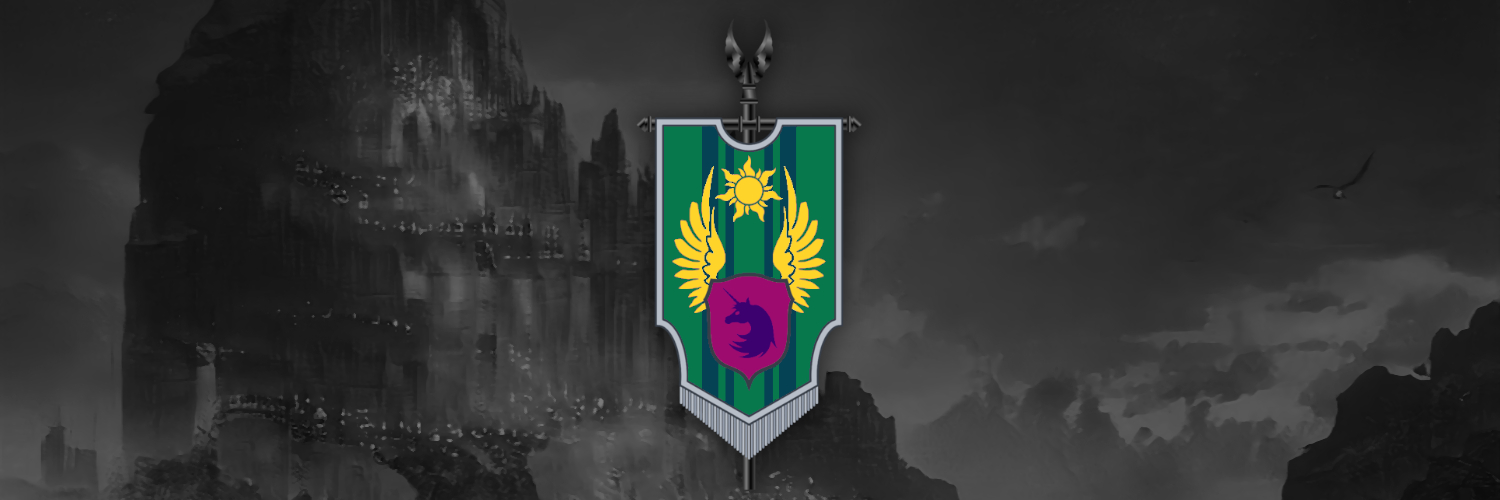
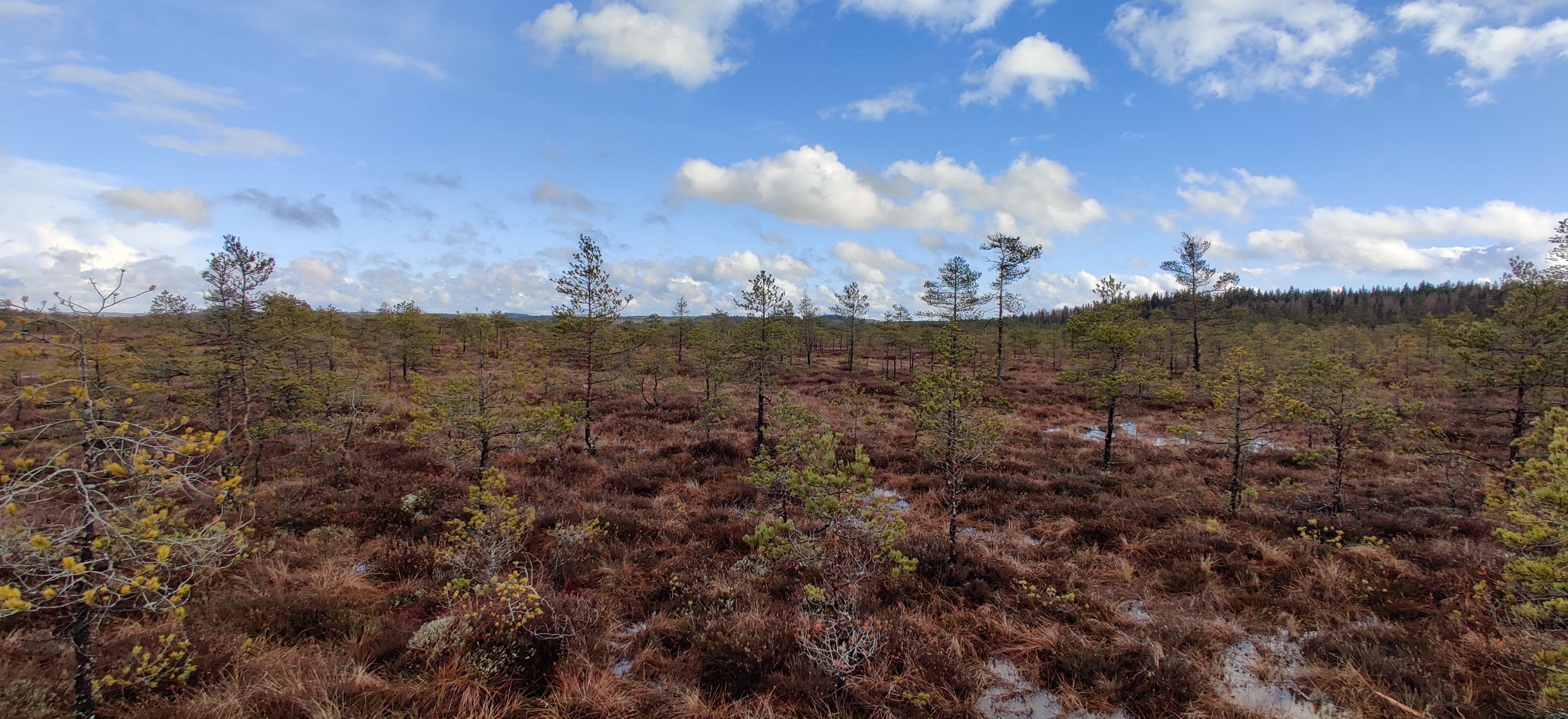

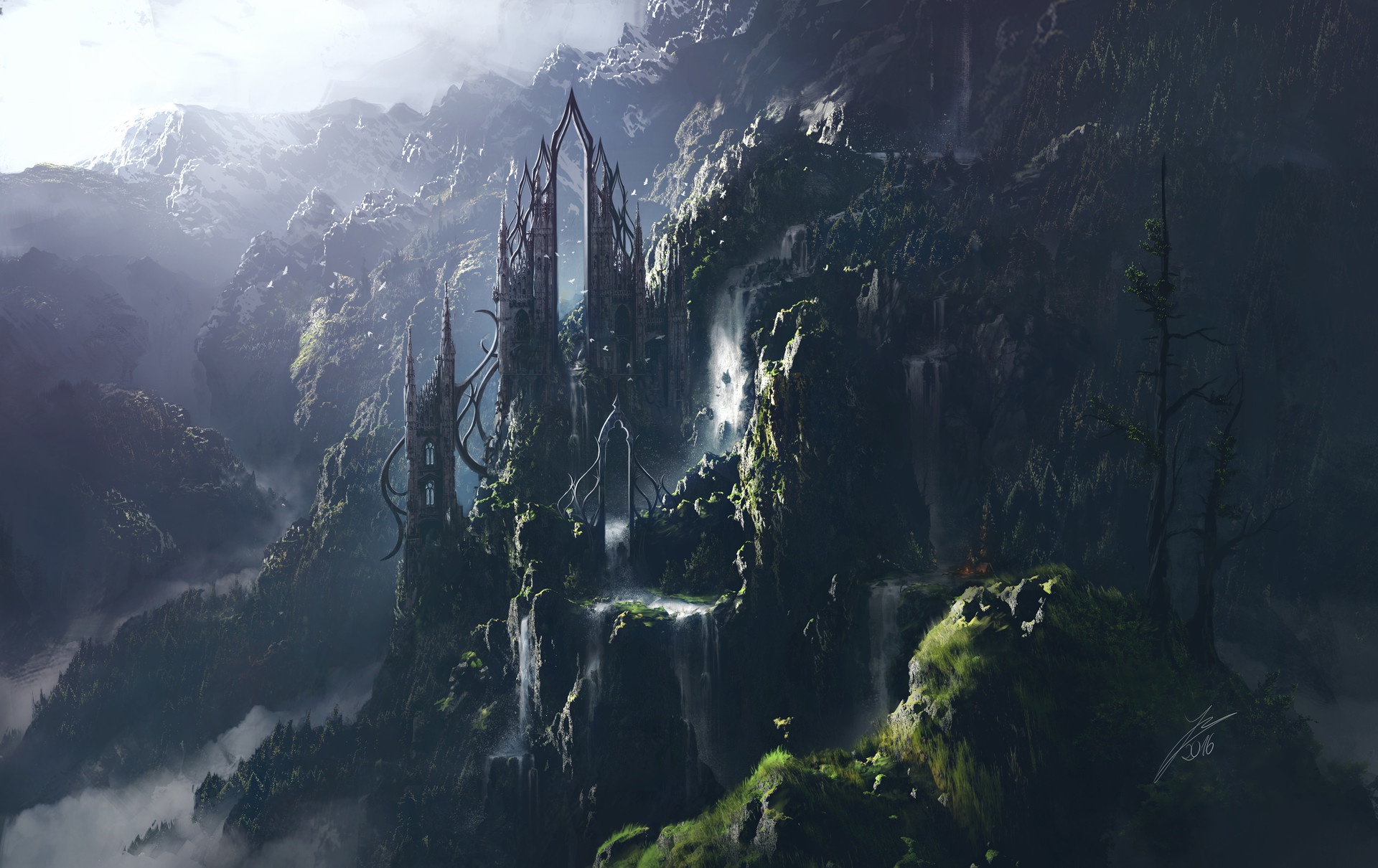


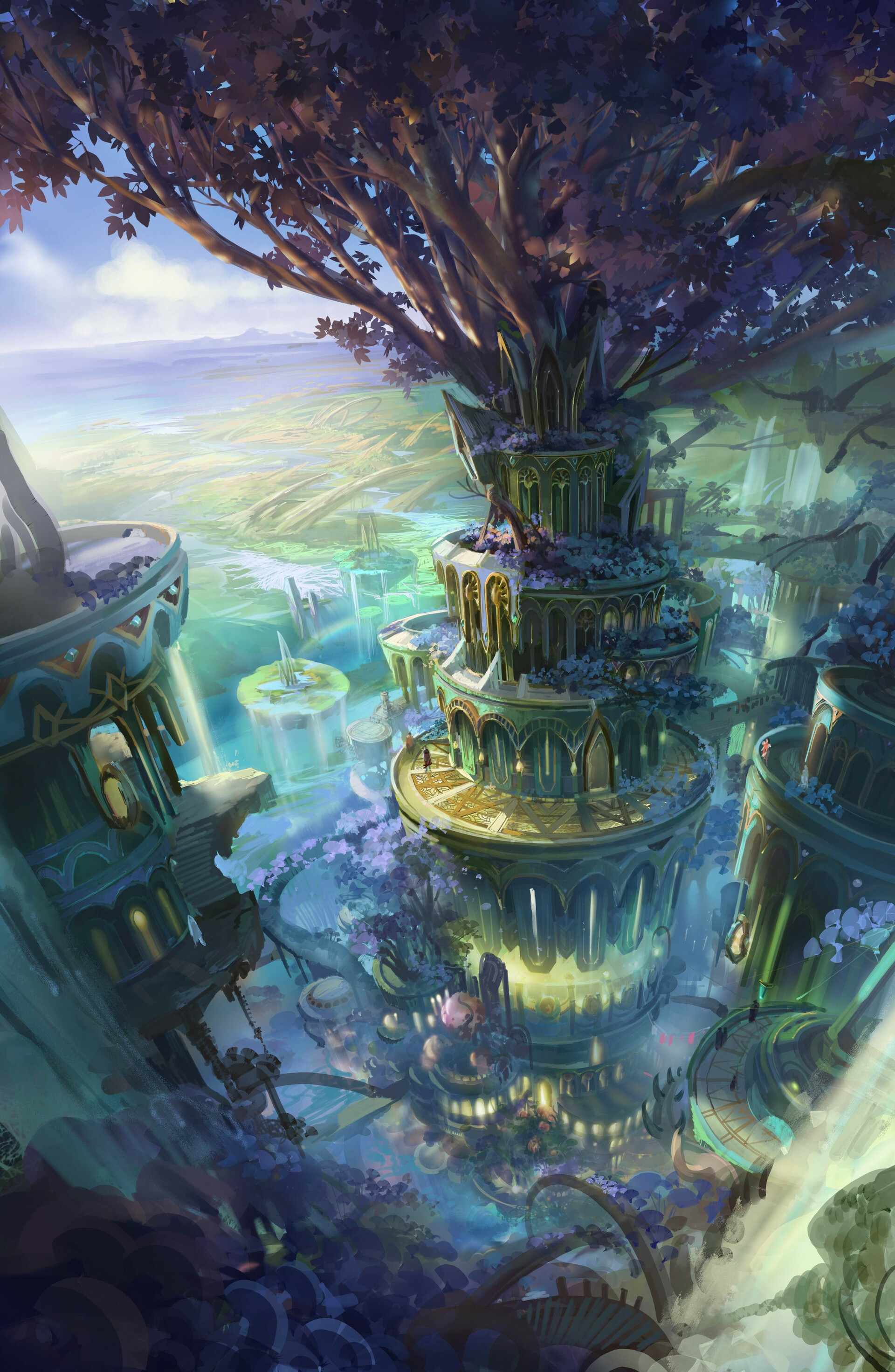
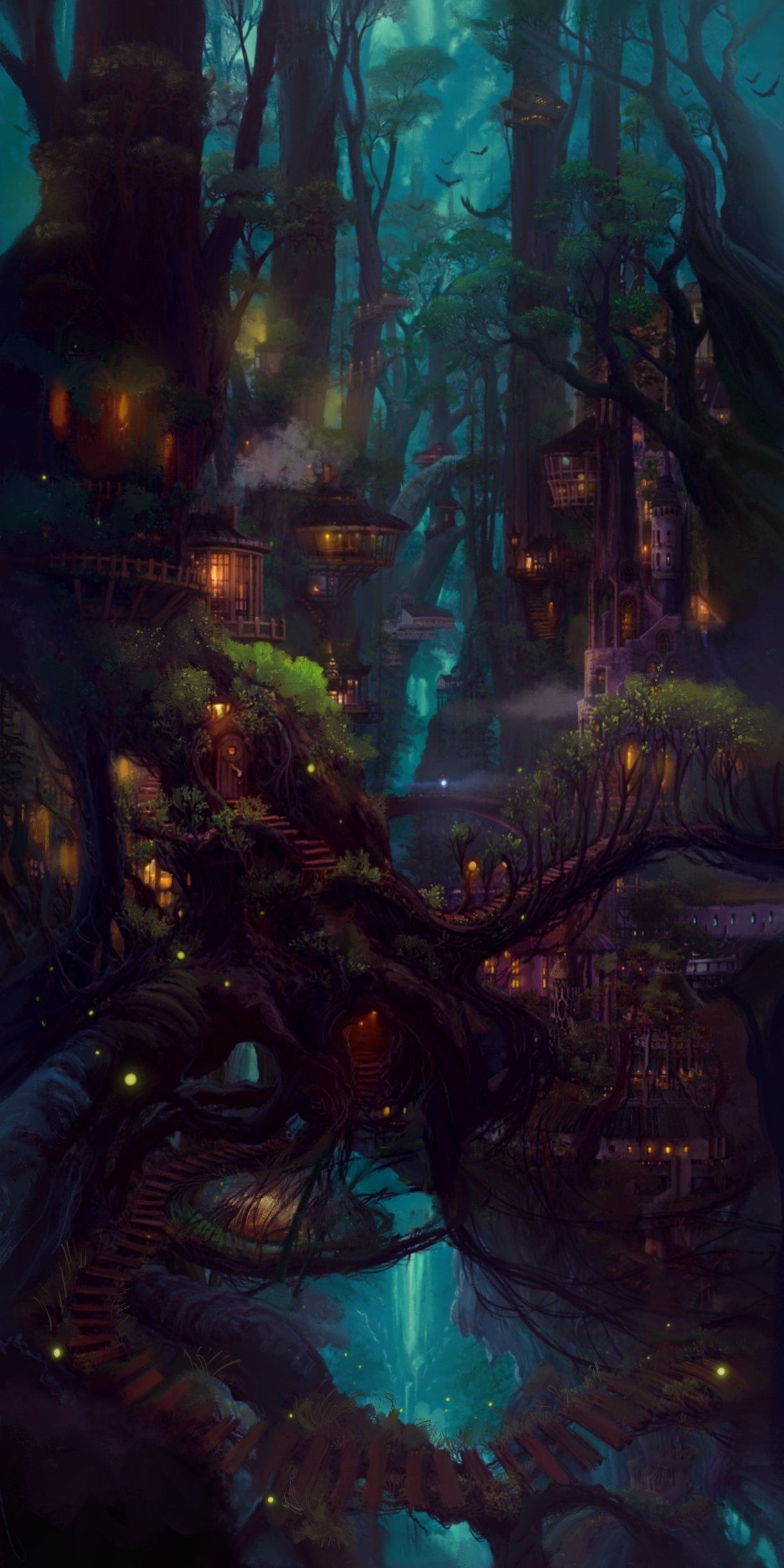
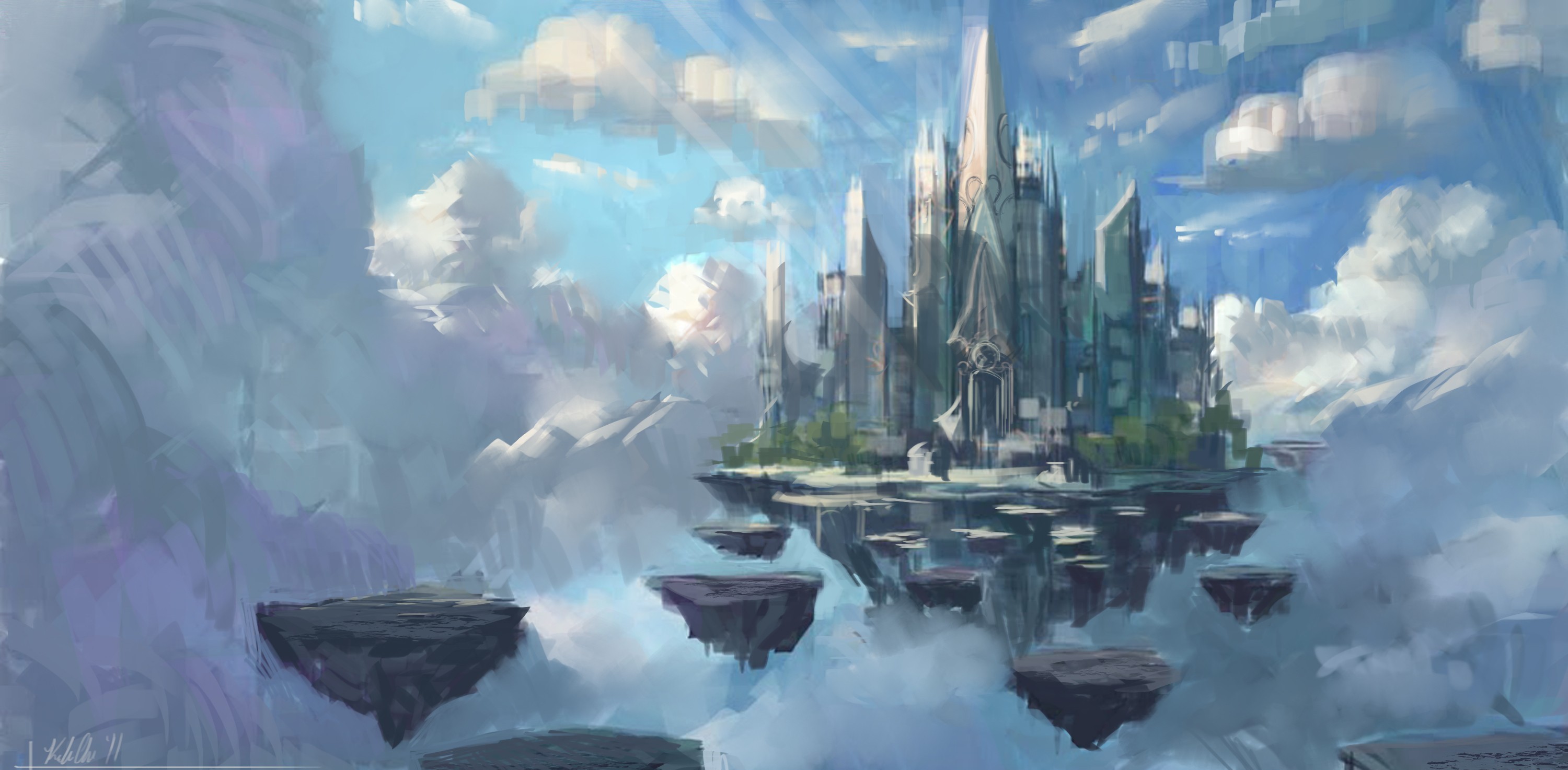
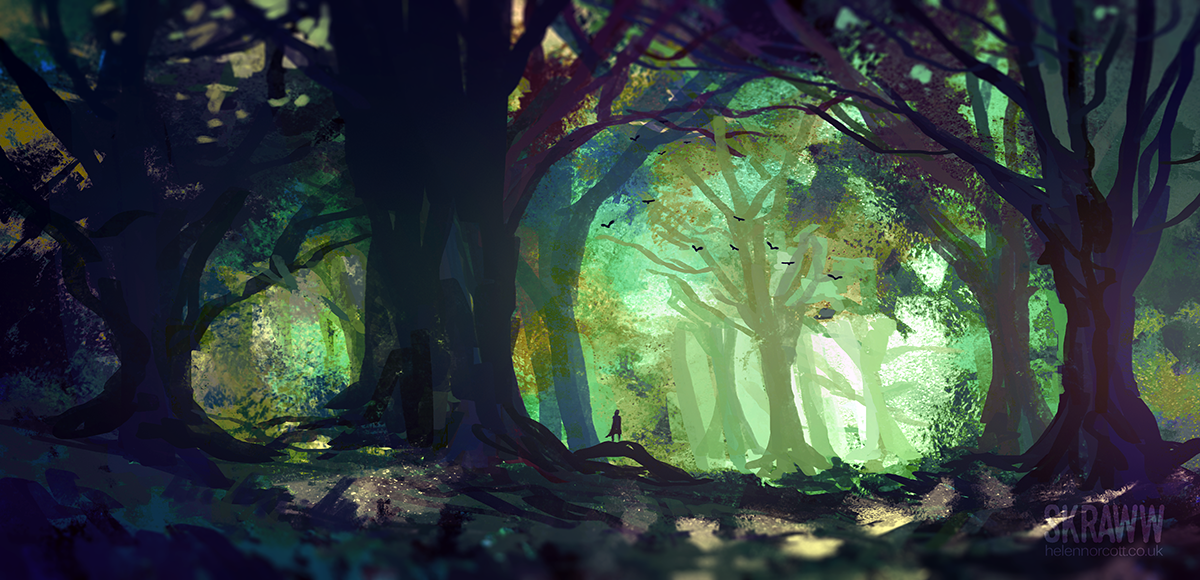
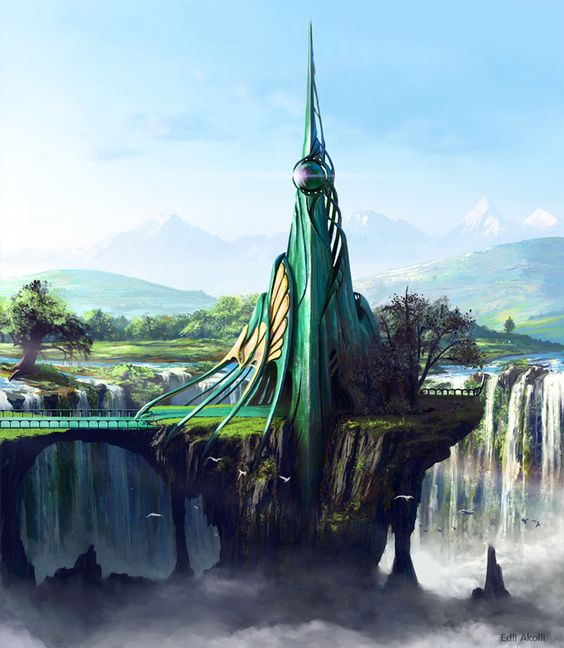

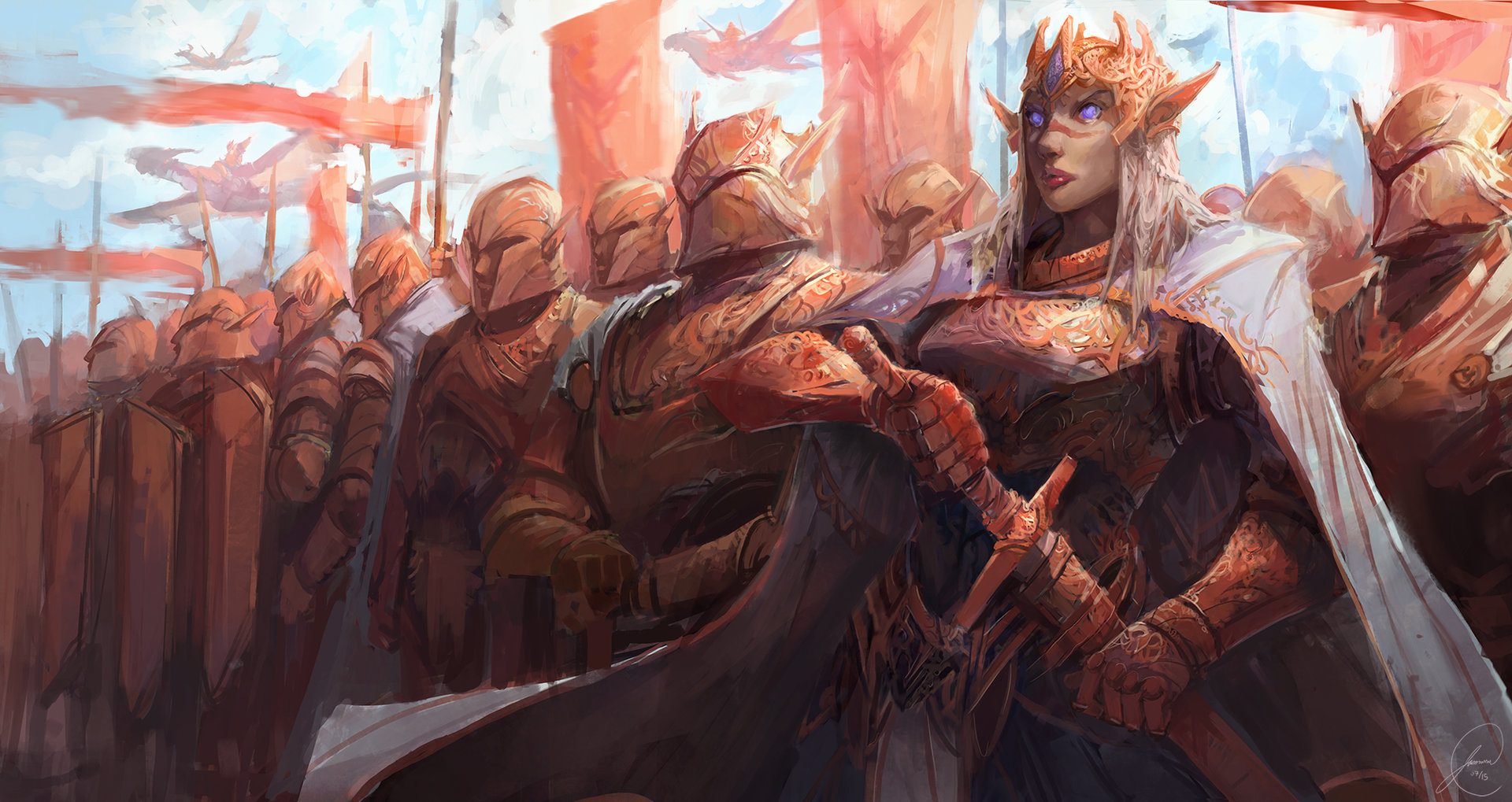
Comments
Author's Notes
This is Amanor's version of a utopistic civilization. I wanted to make Ellondoth much more technologically advanced than other civilizations without running into the usual themes of machinery, industrialization and gunpowder. Magic was the best way, I felt, to explore alternate avenues of societal advancement that did not sacrifice the common fantasy trope of elves being attuned with the natural world. Credit where credit is due
I was inspired to write this article after playing through Sid Meier's Civilization VI. A lot of the angles of observation in this article come from the milestones of the tech and civic trees in that game. The nice little detail of the Last Day of Autumn was mostly taken from the text accompanying an amazing piece of art by Silvia Meiliani. And as for Iona's quote in the sidebar before the text-box on the Eternal Shame -- well, that's mostly just an abominable amalgamation of misquoted wisdom from real-life sources ranging from Santana to the Bible. Thanks again, Civ 6.